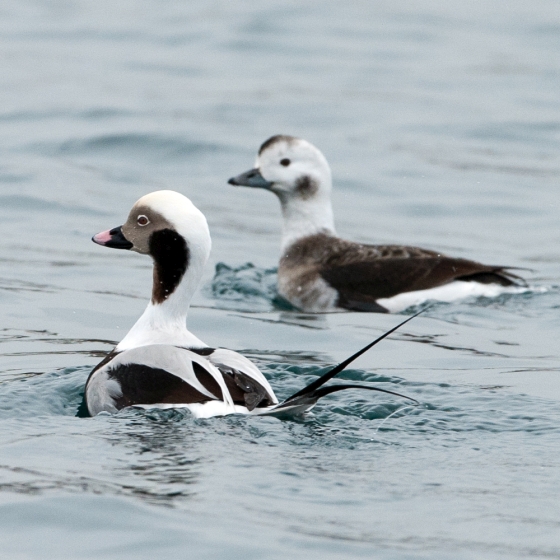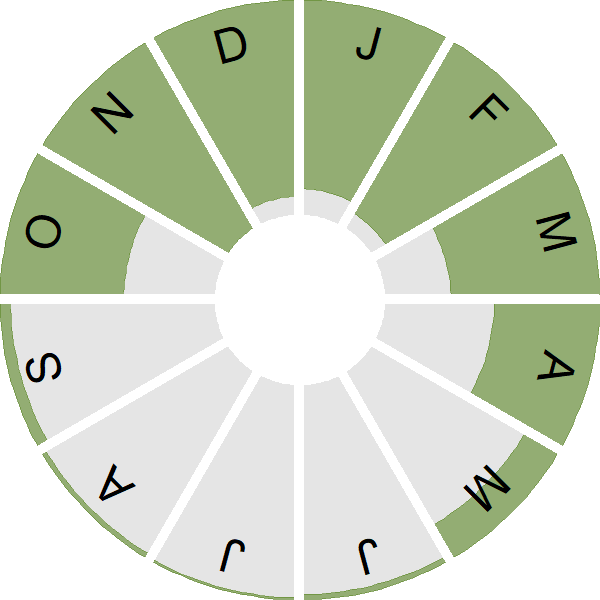Long-tailed Duck

Introduction
The Long-tailed Duck is a winter visitor to UK coastal waters, arriving from their arctic breeding grounds.
Almost all of the world's breeding Long-tailed Ducks are found within the Arctic Circle and, as such, it is hardly surprising that the majority of those wintering in the UK do so in the north, around Shetland, Orkney and north-east Scotland. Smaller numbers are found further south along England's east coast, and a few individuals may be found on inland waters.
BirdTrack data indicate that Long-tailed Ducks begin arriving in UK waters during October and reach their peak in mid-November. It is estimated that around 14,000 birds spend the winter here.

Key Stats
Identification
Songs and Calls
Call:
Status and Trends
Conservation Status
Population Change
Although Long-tailed Duck is a regular winter visitor to the UK, it is a seaduck that inhabits deep waters so is usually found well offshore. It is most abundant around the coasts of northern and eastern Scotland although there are records of smaller numbers of individuals from around the UK. There are no coordinated or regular surveys carried out in the UK for marine waterbirds and no long-term monitoring programmes that adequately cover offshore areas, so it is difficult to gather accurate count data or track population changes for species such as Long-tailed Duck. Despite that, they are picked up on WeBS counts and WeBS data suggest a steady decline since the early 1990s.
Distribution
In winter, Long-tailed Ducks tend to occur well offshore in deep waters, so the numbers detected from the shore may give a misleading impression of distribution and abundance. During Bird Atlas 2007–11
Occupied 10-km squares in UK
2007/08–10/11
or view it on Bird Atlas Mapstore.
2008–11
or view it on Bird Atlas Mapstore.
European Distribution Map
Distribution Change
The small range expansion in winter has mostly been in marginal areas; elsewhere the population has declined.
Change in occupied 10-km squares in the UK
from 1981–84 to 2007–11
or view it on Bird Atlas Mapstore.
from 1968–72 to 2008–11
or view it on Bird Atlas Mapstore.
Seasonality
Long-tailed Ducks are locally common winter visitors, mostly present from October to May.
Weekly pattern of occurrence
The graph shows when the species is present in the UK, with taller bars indicating a higher likelihood of encountering the species in appropriate regions and habitats.

Movement
Britain & Ireland movement
Foreign locations of birds ringed or recovered in Britain & Ireland
Dots show the foreign destinations of birds ringed in Britain & Ireland, and the origins of birds ringed overseas that were subsequently recaptured, resighted or found dead in Britain & Ireland. Dot colours indicate the time of year that the species was present at the location.
- Winter (Nov-Feb)
- Spring (Mar-Apr)
- Summer (May-Jul)
- Autumn (Aug-Oct)

European movements
EuroBirdPortal uses birdwatcher's records, such as those logged in BirdTrack to map the flows of birds as they arrive and depart Europe. See maps for this species here.
The Eurasian-African Migration Atlas shows movements of individual birds ringed or recovered in Europe. See maps for this species here.
Biology
Productivity and Nesting
Nesting timing
Egg measurements
Clutch Size
Survival and Longevity
Survival is shown as the proportion of birds surviving from one year to the next and is derived from bird ringing data. It can also be used to estimate how long birds typically live.
View number ringed each year in the Online Ringing Report.
Lifespan
Survival of adults
Biometrics
Wing length and body weights are from live birds (source).
Ring Size
Classification, names and codes
Classification and Codes
- Order: Anseriformes
- Family: Anatidae
- Scientific name: Clangula hyemalis
- Authority: Linnaeus, 1758
- BTO 2-letter code: LN
- BTO 5-letter code: LOTDU
- Euring code number: 2120
Alternate species names
- Catalan: ànec glacial
- Czech: hoholka lední
- Danish: Havlit
- Dutch: IJseend
- Estonian: aul
- Finnish: alli
- French: Harelde kakawi
- Gaelic: Lach-bhinn
- German: Eisente
- Hungarian: jegesréce
- Icelandic: Hávella
- Irish: Lacha Earrfhada
- Italian: Moretta codona
- Latvian: kakaulis
- Lithuanian: ledine antis
- Norwegian: Havelle
- Polish: lodówka
- Portuguese: pato-rabilongo
- Slovak: ladovka dlhochvostá
- Slovenian: zimska raca
- Spanish: Pato havelda
- Swedish: alfågel
- Welsh: Hwyaden Gynffonhir
- English folkname(s): Ice Duck, Sea Pheasant
Research
Causes of Change and Solutions
Causes of change
Coordinated surveys in the Baltic Sea, where most of the global population of Long-tailed Duck overwinters, have recorded a decline of 59% since the early 1990's. This decline is attributed to low recruitment, caused by low productivity rates, in combination with additional mortality from anthropogenic causes on the non-breeding grounds. It is unclear whether the low productivity rates are caused by failed breeding, fewer breeding attempts or a combination of both. Various contributory factors have been proposed for the low productivity rates, including changing ecological conditions and increased predation on the breeding grounds due to climate change. Three anthropogenic causes: recurrent operational oil discharges, fishing bycatch, and hunting, all of which have resulted in direct mortality on the non-breeding grounds, are thought to have reduced survival, potentially exacerbating the issues on the breeding grounds [Hearn et al. 2015].
Publications (1)
Behavioural responses of non-breeding waterbirds to marine traffic in the near-shore environment
Author: Jarrett, D., Calladine, J., Cook, A.S.C.P., Upton, A., Williams, J.,Williams, S., Wilson, J.M., Wilson, M.W., Woodward, I. & Humphreys, E.M.
Published: 2022
Marine traffic is increasing globally, but there has been little research investigating the impact of this disturbance, particularly for non-breeding populations in near-shore environments. This study ...
02.09.22
Papers

More Evidence
More evidence from Conservation Evidence.com
Partners
Citing BirdFacts
If you wish to cite particular content in this page (e.g. a specific value) it is best to use the original sources as linked in the page. For a more general citation of the whole page please use: BTO (20XX) BirdFacts Species: profiles of birds occurring in the United Kingdom. BTO, Thetford (www.bto.org/birdfacts, accessed on xx/xx/xxxx).

